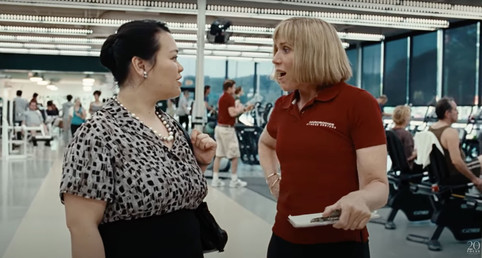Squeezing out NYC and Philly
- DesignShed Org

- May 28, 2022
- 9 min read
Updated: Nov 13, 2022
Cofounder Petia Morozov speaks with design historian Gabrielle Esperdy about the city of the future, and spoiler alert, it's New Jersey.

Gabrielle Esperdy, photographed with her vehicle of choice for her series, "American Road Trip." Image courtesy of Gabrielle Esperdy.
In her Issue 1 essay, "The City of New Jersey,” design history scholar Gabrielle Esperdy explores what future cities might look like, and no surprise, she’s betting that they’ll resemble America's densest state – all 8,723 square miles of it.
With such a bold claim, we wanted to follow up with Esperdy and ask her to play out a few scenarios with us: who should play the mayor in the cinematic version of this city, what is it about New Jersey that attracts so many utopian experiments, and should we really care what other cities think? This conversation gathered a lot of momentum, so here’s our condensed version, conducted and edited by Dense cofounder Petia Morozov.
"There's such a parochialism, not just in terms of ignoring New Jersey between Philadelphia and New York, but also a literal parochialism about cities as cities. That if it's not in whatever 'the city' is, it's somehow less than." – Gabrielle Esperdy
PETIA MOROZOV: Where are you at?
GABRIELLE ESPERDY: I am in Pittsburgh at the very attractive Westin. I took the train here yesterday.
PM: Oh, good for you. Was it a nice train ride?
GE: Parts of it were really great. Obviously, the New York/Philadelphia is familiar to all of us. But then once you start turning west, you're paralleling the Lincoln Highway and then it goes through farmland. When we were going through Lancaster County – and I'm not making this up – there were Amish horses running alongside the train. And then all the Amish kids, who were at recess, they stopped and waved as the train went by.
PM: Oh my god, how is that possible?! It's like seeing it for the first time.
GE: It was like being in America in 1900, or in a David Lynch version of that.
[Laughter]
PM: That was going to be one of the things that I wanted to ask you about: if someone were to make a movie about "The City of New Jersey,” who would be the filmmakers?
GE: I would say, David Lynch and Wim Wenders. Those would be the two. I guess I'm answering that question with reference to when I came of age as a movie goer. That stuff imprints deeply! I think Lynch, because he can appreciate the surreal quality. And Wenders, because he has that ability, especially in a movie like Paris, Texas in which he caught the beauty of the landscape, to see its underbelly without focusing on one versus the other.
PM: Yes!
GE: But I also think the Coen Brothers. Frances McDormand as narrator?
PM: Please, can we have Frances in any movie, really? I don't care what the movie is about.
Film stills of "Burn After Reading." Film by Joel and Ethan Coen, starring Frances McDormand, filmed in New Jersey.
PM: Leading up to this conversation, I've been doing a very unscientific survey – whether it's Curbed or Thrillist or online media – that is looking at cities from a very pop cultural perspective. Just wondering, are there any contemporary cities that you're referencing in your essay, are they showing up?
GE: I think Jersey City is probably coming closest in terms of, I hate to say, buzz. But that's part of the issue. There's such a parochialism, not just in terms of ignoring New Jersey between Philadelphia and New York, but also a literal parochialism about cities as cities. That if it's not in whatever "the city" is, it's somehow less than.
Think about Michelle Grabner's work as a curator, when she opened that gallery – was that in the nineties or the early aughts? – “The Suburban.” I think she was in Illinois at the time and had moved with a kid and a husband. It was pilloried! Everyone couldn't resist calling it "suburban soccer mom art." It was like, wow, fuck you! It's comparable to the perception of what's happening in Montclair, by people who are in the five boroughs. Right? Like, is there something interesting happening out there?
PM: [Laughs]
GE: But I think there's also power in ignoring that. It's saying, you know what, we don't actually need to pay attention to the noise around us, we can simply focus on what is here.
PM: Yeah.
GE: It's attention.

Artist Michelle Grabner. Photo by Adam Ryan Morris for the Milwaukee Magazine.
PM: You know, I wonder if there are other lenses that we could take to understanding why New Jersey matters, as a place where the contemporary city can emerge and perhaps flourish. But in a way, that is going to have a lot of friction between people who want to keep it called the suburbs, and then some people who are like, no, it's way more urban!
GE: I like to think of the metropolitan landscape as a way of moving beyond the binary of urban-suburban, because it implies an urbane-ness. See, we have to call out the dog whistles about urban somehow being connected to this notion of the "inner city,” whatever that means. And that's of course, part of it. When Trump was in office, he articulated what always struck me as a 50-year-old proposition about how scared white people articulated what urban places looked like. I think that there's a lot of residue of that.
But to go back to your notion of lenses, is to think not about, let's say, urbanism infiltrating in these places, but urbanism returning. If you look at the Northern part of the state, there were railroad towns that happened to have a sub-urban connection to larger cities. Places like Montclair never stopped being what it was, but it began to effloresce as people moved there, right? The Brooklyn refugees, the-what-have-you.
When I think urbanistically about the history of the United States in the 20th century, when they were using the 1930 census, and then the 1920 census, they had a category called “cities” that were basically up to 50,000 people, which is a really small city! The vast majority of cities in the United States were small – and yet they were cities, like Asbury Park.
Montclair to me – when you look at the museum, when you look at the civic and cultural infrastructure of the place – of course, this is a city. It's a pretty city, and it's a city that has maintained a certain leafiness, but that doesn't mean it's not what cities look like. I think part of the problem is that when people think city, they think “industrial city.” They think Manhattan, which is not what cities look like, it's what Manhattan looks like. So part of it is about reframing what we're talking about when we're talking about city.
PM: You're reminding me of the Meadowlands Planning Commission. They had lots of people coming from all over the world to study the dynamic balance between environmental concerns and economic ones, outside of governmental boundaries. All of that was a very radical way to start an unplanned city. I wonder if you can think of any examples in addition to the Meadowlands, that sort of started out that way. Examples of an unplanned, ground-up approach.
GE: It is interesting to think of the kind of organizational and legislative model of the authority. We can also think about the Port Authority. Because it is dual state, it's already creating something that transcends and transgresses. And so, the Port Authority is an interesting model, relative to regulation and lack of regulation, because it's like, where are the places that are outside of the octopus arms of the Port Authority.
PM: Right.
GE: But the other thing is the Regional Plan Association itself. Look at the much-lauded 1929 plan, which included the replanning of the Meadowlands as part of the regional plan of New York. My PhD student wrote extensively about the planning of the Meadowlands and that project. There were these pictures in the regional plan that made the Meadowlands look like the Netherlands. Yeah, yeah, we can build on wetlands. We know how to do this, and we're not, you know, killing nature. It's not all landfill. We're actually just going to somehow, strategically, weave urbanism into this. And of course, it never happens.

Regional Plan Association's 1930 Plan for the "Hackensack Meadows." Image courtesy of Regional Plan Association.
There are other examples we can dig up, like all the utopian communities that flourished (I don't think you can ever call them “flourishing”). They flourished for a moment, one after another after another. The trace of the Great American Phalanx, or whatever it was called, in Red Bank? That footprint of utopia is all over the state.
PM: I love that you're bringing it up. That’s what has always been our secret sauce as a state. We experiment more, and not all of them work out! Maybe they're too radical. Maybe they just have their little moment, and they turn into something else. Or are they just peter out. The fact that the Netherlands and the Dutch continue to come back to this spot just has me thinking, we don't realize that we're a Petri dish for other places in the world.

Image North American Phalanx. North American Phalanx, Country Route 537, Monmouth County, New Jersey (photographer unknown). Courtesy Library of Congress, Prints and Photographs Division, Washington, D.C.
GE: My summer project is to finally finish the New Jersey 100 for [Society of Architectural Historians] Archipedia. That's been on my to-do list forever. I've been working on it slowly but surely. And then in the fall, I'm finally going to teach a class that I've only taught once, called “Delirious New Jersey.” I'm going to be teaching that again in the spring of next year. I'm really looking forward to that.
PM: Can I sit in on that? [laughs]
GE: The Dense piece was the first published part of this thing that I've been working on for a while, which is about doing for New Jersey what [Reyner] Banham did for Los Angeles. It's not that you're an apologist, you're just taking a look around and saying, look at everything that's here. I almost mean that literally, because I think you could find what the comparable ecologies of New Jersey are, and some of them are not all that different from the ones of Los Angeles.
PM: No. No, definitely not.
GE: In terms of future projects, are you familiar with Chris Taylor's Land Arts of the American West?
PM: No.
GE: You should be, because Dense has the potential to be an itinerary for a New Jersey equivalent of Land Arts of the American West. It's a field program. I've always wanted to do a summer abroad in New Jersey.
PM: Let's do it! Anytime I have somebody coming in from out of town, they get the alternative tour of New Jersey like a rite of passage. That tour has changed because some of these things are no longer in existence. For instance, some of the overly chemicalized landscapes along the Hackensack River. If you're really going to study what nature is going to look like and what the post-human is going to look like, you've got to come to New Jersey!
Was there anything else that you had a thought about, that you didn't realize perhaps this essay was touching on, and that you’re reflecting back on now?
GE: Yes... phragmites.
PM: [Laughs]
GE: It didn't end up in the piece, but I became obsessed with phragmites because I wanted to somehow use phragmites as a way of getting at density, growth and change. They're astonishingly beautiful. Talking about that alternative tour, if you're driving or taking the train from New York down to Asbury Park, people are like, they’re so beautiful. They’re tall, waving in the breeze, but they're also killing everything! There was something about that as a metaphor.
The fact that they're everywhere in New Jersey speaks to the singular importance of the ports of Newark and Elizabeth, right? There's a reason that they ended up catching hold here. There's that painting by William Ranney, of duck hunters in the Meadows. Do you know that one, with the little dog in the front?
PM: Yes!
GE: I realized, those Meadowlands don't exist anymore. That's the thing I became obsessed with, and I'm sure it'll turn up in my New Jersey book. That image of duck hunters, with a contemporary image of growth. It is beautiful, and it has all this other stuff.
PM: It's a great metaphor. It's rhizomatic in the way that it spreads. I love that connection. Well, this has been wonderful. Thank you so much, Gabrielle! I really enjoyed this conversation.
GE: Oh, it's my pleasure! It's just so stimulating to talk about all these ideas. Having these kinds of conversations is endlessly fascinating.

Duck Hunters on the Hoboken Marshes, New Jersey, 1849 (oil on canvas) by William Tylee Ranney (1813-57)
Gabrielle Esperdy was a New Jersey public scholar in the humanities and is a Professor at NJIT. The author of Modernizing Main Street and American Autopia, she is completing a history of significant buildings and sites in the Garden State.
Booth, Please is our weekly newsletter that explores the dreams, discoveries, confrontations, and epiphanies that emerge when design meets New Jersey — all set within the comforts of the world's diner capital. Subscribe below and cozy up every Sunday.


















Comments